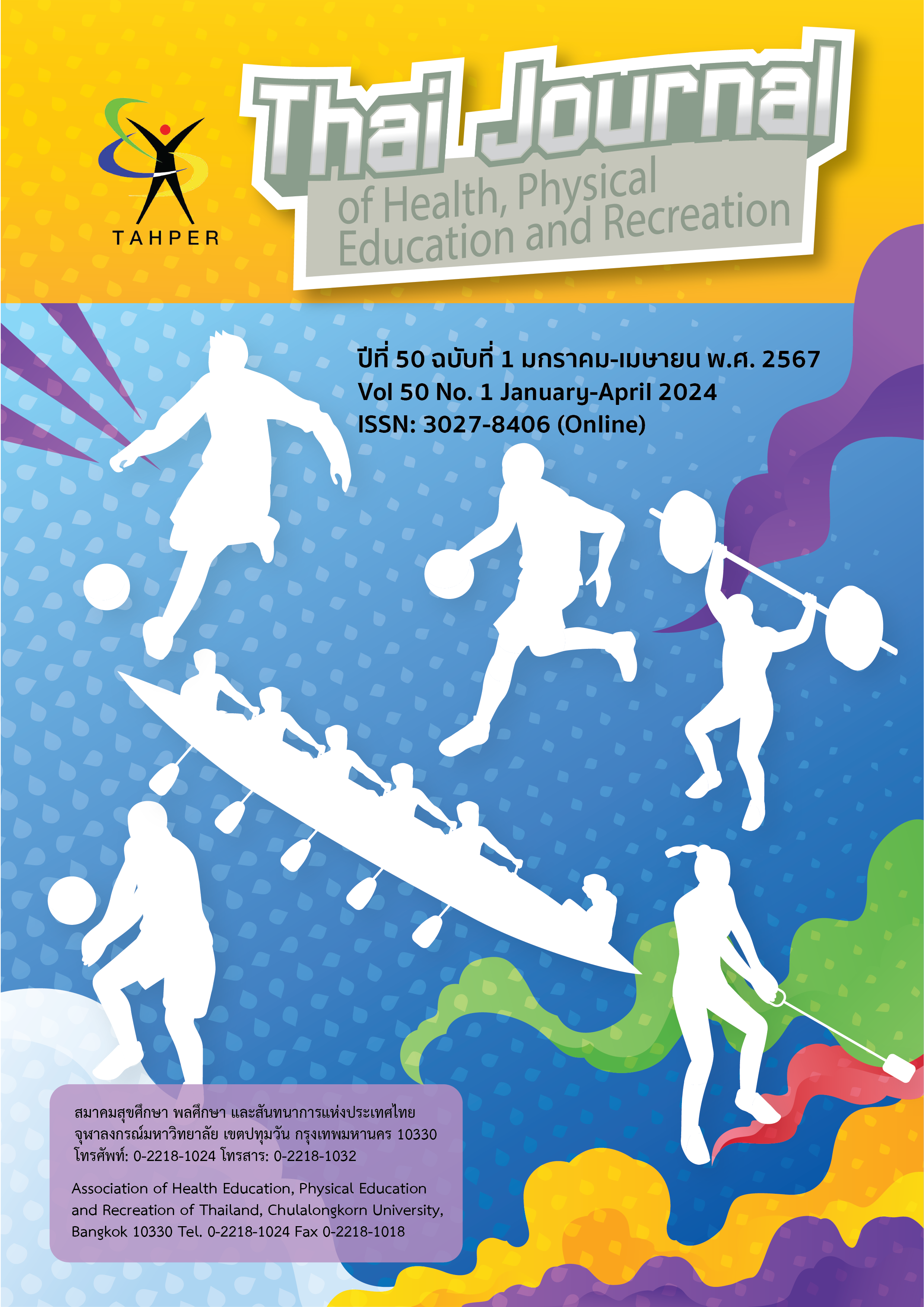A Confirmatory Factor Analysis of Mental Toughness Influencing Performance of Emergency Medical System Personnel, in the Situation of the New corona virus disease 2019 Outbreak
Main Article Content
Abstract
This research aimed to analyze the confirmatory psychosocial resilience components of emergency medical personnel during the outbreak of the novel coronavirus 2019. The study employed a quantitative research design with a sample group consisting of emergency medical doctors, nurses, emergency medical practitioners, and volunteer emergency responders, totaling 223 individuals. The participants were selected using a simple random sampling method. The research instrument used was a questionnaire measuring the psychosocial resilience of emergency medical personnel during the outbreak of the novel coronavirus 2019, with seven levels of approximation. The questionnaire demonstrated a 0.812 alignment with the research objectives and had a Cronbach's alpha reliability coefficient of 0.878. Data analysis involved descriptive statistics, inferential statistics, and structural equation modeling. The research findings indicated:
1) The psychosocial resilience components of emergency medical personnel during the outbreak of the novel coronavirus 2019 comprised four factors: challenging motivation, determined focus, self-control, and confidence, and 2) The confirmatory results of the psychosocial resilience components of emergency medical personnel during the outbreak of the novel coronavirus 2019 were consistent with observational data. The chi-square value was 103.224 with degrees of freedom (df) equal to 94 and a statistically significant p-value of 0.242. The Comparative Fit Index (CFI) was 0.997, the Goodness of Fit Index (GFI) was 0.969, the Adjusted Goodness of Fit Index (AGFI) was 0.944, and the Root Mean Square Error of Approximation (RMSEA) was 0.017.
Article Details

This work is licensed under a Creative Commons Attribution-NonCommercial-NoDerivatives 4.0 International License.
Critical thinking in journals is the right of the author. The Association of Health Education, Physical Education and Recreation of Thailand is not always required, to create diversity in ideas and creativity.
ความคิด ข้อวิพากษ์ในวารสารเป้นสิทธิของผู้เขียน สมาคมสุขศึกษา พลศึกษา และสันทนาการแห่งประเทศไทยไม่จำเป็นต้องเห็นชอบด้วยเสมอไป เพื่อให้เกิดความหลากหลายในความคิดและความสร้างสรรค์
References
Arnetz, J. E., Goetz, C. M., Arnetz, B. B., & Arble, E. (2020). Nurse reports of stressful situations during the COVID-19 pandemic: Qualitative analysis of survey responses. International Journal of Environmental Research and Public Health, 17(21), 8126.
Davis, N. J. (1999). Resilience, Status of the Research and Research-Based Model. Retrieved April 22, 2022, from http://menalhealth. sahsa. gvo/shoolv iolence/5-8resilience.asp
Khoshouei, M.S. (2009). Psychometric Evaluation of the Connor-Davidson Resilience Scale (CD-RISC). Using Iranian Students, International Journal of Testing. 9(1): 60-66.
Lundman B., Strandberg G, Eisemann M., Gustafson Y. & Brulin C (2007). Psychometric properties of the Swedish version of the resilience scale. Scand J Caring Sciences. 21(2): 229-237.
Magill, E., Siegel, Z., Pike, K., & Kaiboriboon, K. (2021). Human factors in emergency medicine: A systematic review. The American Journal of Emergency Medicine, 40, 44–51.
Middleton. S. C., (2004b). Mental Toughness Test: Is the Mental Toughness Test Tough Enough? International Journal of Sport and Exercise Science.
Rui, Z., Lian, Z., Yang, Y., & Zhan, X. (2020). Analysis of workload and stress among emergency physicians in COVID-19 pandemic. Emergency Medicine Journal, 37(8), 493–496.
Shanafelt, T., Ripp, J., & Trockel, M. (2019). Understanding and addressing sources of anxiety among health care professionals during the COVID-19 pandemic. JAMA, 323(21), 2133–2134.
Soper, D. S. (2023). Structural Equation Model Sample Size Calculator. Retrieved December 25, 2023 https://www.analyticscalculators.com/calculator.aspx?id=89.
กรมสุขภาพจิต, (2551). ลักษณะของบุคคลที่มีความเข้มแข็งทางใจของกรมสุขภาพจิต. คู่มือ การสร้างสรรค์พลังใจ ให้วัยทีน. พิมพ์ครั้งที่ 1. นนทบุรี : บียอนด์ พับลิสชิ่ง จำกัด
ภัคนพิน กิตติรักษนนท์ พาสนา คุณาธิวัฒน์ ศรัณย พิชญอักษร และธิดารัตน์ ทิพโชติ. (2021). การพัฒนาและนำเทคโนโลยีสุขภาพจิตการเสริมสร้างพลังใจไปใช้ในการดูแลผู้ได้รับผลกระทบทางจิตใจจากสถานการณ์การแพร่ระบาดของโรคติดเชื้อไวรัสโคโรนา 2019. วารสารจิตวิทยาคลินิกไทย (Online), 52(2), 33-48.
รัฐธรรมนูญแห่งราชอาณาจักรไทย พุทธศักราช (2550). กฎหมายรัฐธรรมนูญแห่งราชอาณาจักรไทย พ.ศ. 2550 มาตรา 52. แก้ไขเพิ่มเติมถึง (ฉบับที่ 2) พุทธศักราช 2550/สำนักงานเลขาธิการวุฒิสภา. ครั้งที่พิมพ์, พิมพ์ครั้งที่ 2.
วราพร เอราวรรณ์ (2553). การพัฒนาแบบวัดภูมิต้านทานทางอารมณ์ สำหรับนักศึกษาปริญญาบัณฑิต โดยใช้เทคนิคแผนผังกลุ่มเชื่อมโยง การสัมภาษ์แบบ MMI และการวิเคราะห์พหุวิธี 2 ระดับ. กรุงเทพฯ : คณะครุศาสตร์ จุฬาลงกรณ์มหาวิทยาลัย, 2553.
วราภรณ์ เหลืองวิไล ศิรินทร์รัตน์ กาญจนกุญชร และปิ่นกนก วงศ์ปิ่นเพ็ชร์. (2021). พัฒนาการจิตอาสาตามบริบทของประเทศไทย. วารสารปัญญาภิวัฒน์, 13(1),336-350.
วิภา สุวรรณรัตน์ มาลี เกตแก้ว และกัณณวันฑ์ สกูลหรัง. (2022). การพัฒนาความเข้มแข็งทางใจในชุมชนในสถานการณ์ระบาดของโรคติดเชื้อไวรัสโคโรนา 2019 (COVID-19):none. วารสารวิชาการสาธารณสุขชุมชน, 8(01).
อุษณี ลลิตผสาน, และมารยาท โยทองยศ (2555). การพัฒนามาตรวัดการฟื้นคืนได้:การวิเคราะห์องค์ประกอบเชิงสำรวจและองค์ประกอบเชิงยืนยัน. การประชุมวิชาการมหาวิทยาลัย กรุงเทพ. การประชุมจดัโดยมหาวิทยาลยักรุงเทพ, วิทยาเขตกล้วยน้ำไท.


